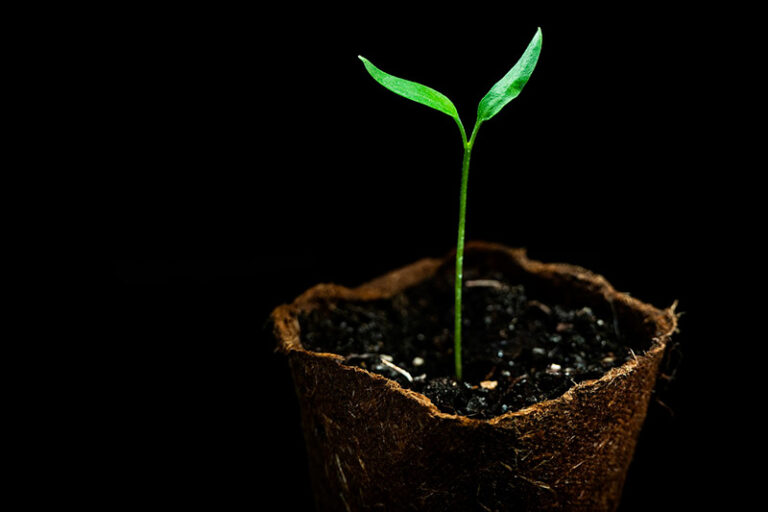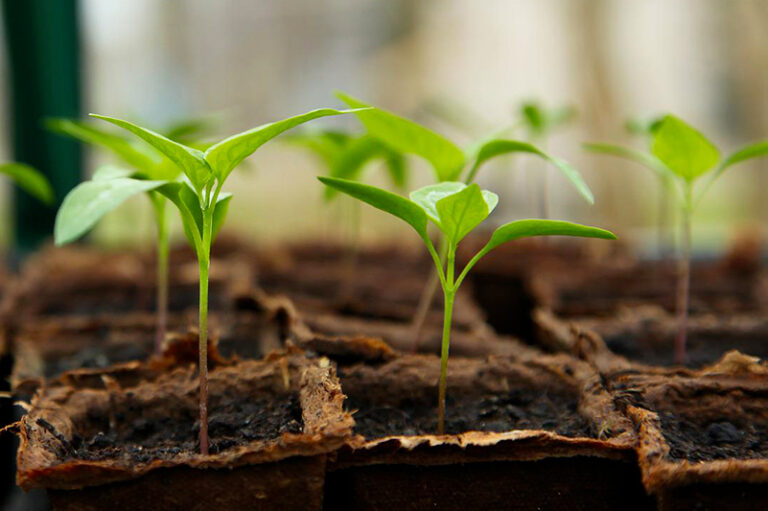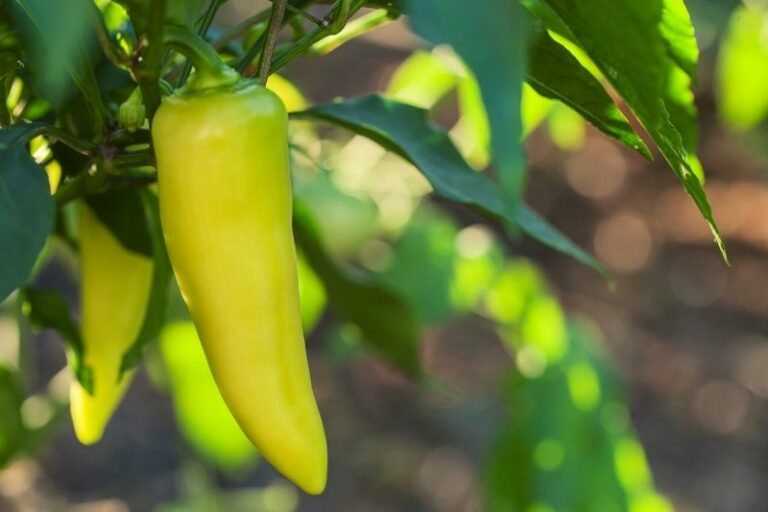The banana pepper plant is a beautiful and tasty addition to any garden. Also called banana chillis, they are mild in flavor, with a slightly sweet taste that is perfect for adding to salads, sandwiches, and other dishes. They are also very attractive plants, with bright green leaves and cheerful yellow fruit.
Banana chillis are a great option for gardeners who want to grow peppers but don’t have a lot of space, because the plants don’t grow overly big.
Banana peppers can be easily grown in containers and pots, which means they can be placed anywhere in the garden or on a patio or balcony.
In this article, we will discuss the necessary steps for growing banana peppers in a pot.
Table of Contents
- When Is the Best Time to Plant Banana Peppers?
- Choosing the Best Container for Growing Banana Peppers
- What Does a Banana Pepper Need To Grow Well in a Container?
- When Can You Harvest Banana Peppers?
- Conclusion
- FAQ
When Is the Best Time to Plant Banana Peppers?
Banana peppers can be grown from seeds or cuttings. Most gardeners prefer seeds.
You can start the seeds indoors about eight weeks before the last frost date in your area if you are planning to place the containers outside. Before you place the containers outside, wait at least a week or two after the last frost.
To start the seeds, you can use various types of planting containers. I prefer either peat pots or peat pellets because they make transplanting the seedlings much easier.
Pepper seeds require warm soil to germinate. Therefore place the containers with the seeds on a heat mat or in a warm room. The room temperature should be around 70 degrees Fahrenheit or 21 degrees Celsius for the best results.
Banana pepper seeds generally germinate within 10-14 days and problems are rare. If you do have problems with germination, make sure that the planting containers are moist but not waterlogged and that the room temperature is as mentioned above.
The seedlings will be ready for transplanting to their final containers about 4 weeks after sprouting or when they have three sets of true leaves. True leaves are the second set of leaves that appear after the seed leaves.

Tip: Is it too late to start the seeds? Don’t worry! Banana pepper seedlings or small plants are available at most garden centers or hobby markets. Just transplant them into a bigger pot and you are good to go.
Choosing the Best Container for Growing Banana Peppers
It is vital to choose the right container for your banana pepper plants. If you choose a container that is too small, the roots will become overcrowded and the plant will not be able to grow properly.
How big of a pot do you need for banana peppers?
Banana peppers like many other peppers have fairly large root systems, so you will need a pot that is at least 12 inches wide but if you can choose an even bigger pot such as 16 or 18 inches wide. 5-gallon pots are about ideal.
Drainage is also important for banana peppers, so make sure the pot you choose has drainage holes in the bottom. Some pots come without drainage holes, so if you choose one of those make sure to drill some yourself.
The type of pot you choose is not crucial and I had grown banana peppers in plastic and terracotta pots with equal success.
Can banana peppers be grown in grow bags?
Banana peppers can be successfully grown in grow bags. If you don’t know what grow bags are, they are essentially large bags that serve as pots. They are made out of various materials such as plastic, jute, or fabric.
Growbags tend to provide excellent drainage due to the porous nature of the material they are made out of. They are often used by professional growers but they work just as well for the home gardener.
One thing I love about grow bags is that they are so easy to move around thanks to the handles. Apart from the really big ones though.
Another bonus is the fact that they are collapsible, so they don’t take up a lot of space when not in use during winter. Just stack them up and put them away until next season.
Grow bags do have some disadvantages you might want to learn about before you make the switch though.
Can you plant multiple banana pepper plants in one pot?
Multiple banana peppers can be planted in one pot, but it is best to give them each their own space. The plants should have at least 12 inches (30 cm) of spacing between them, so make sure your pot is big enough to accommodate multiple plants with this amount of space in between each one.
I have to say though that I had no problems growing multiple banana pepper plants in one pot without adhering to the 12 inches of spacing and my plants still did just fine.
Being able to plant multiple plants in one pot is a great space-saving tip for those with limited gardening space. It’s especially great for those who want to grow peppers on their balcony.

What Does a Banana Pepper Need To Grow Well in a Container?
Although banana peppers are not overly demanding plants, there are a few things they need to grow well in a pot.
What type of soil do banana peppers need?
Banana peppers need well-drained, nutrient-rich soil to grow well in a pot. It is best to use a potting mix that is designed for peppers or other vegetables. You can also make your own potting mix.
There are many recipes online that you can follow.
One of my favorite recipes is to mix equal parts of peat moss, perlite, top loam, and compost. Peat moss will take care of water retention so that the soil doesn’t dry out too quickly, perlite will improve drainage and aeration, top loam will provide volume, and compost will provide nutrients.
This potting mix can be used for pretty much all types of chili peppers, not just banana peppers. You can of course substitute most of the ingredients with something else. For example, you can use sand instead of perlite.
How much sunlight do banana peppers need?
Banana peppers, like most other peppers, need a lot of light to grow well. They need at least 6 to 8 hours of sunlight per day. Therefore, it is best to place the containers in a sunny spot. Just don’t forget that pots can dry out quickly in direct sunlight, so make sure to check the soil regularly and water when necessary.
If you are growing banana peppers indoors make sure they are placed near a sunny window which is usually the one facing south. If you don’t have a spot that gets enough sunlight you can supplement with grow lights.
What kind of temperatures do banana peppers need?
Banana peppers thrive in temperatures ranging between 60 to 90 degrees Fahrenheit or 16 to 32 degrees Celsius.
If the temperature gets too high, the plants may start dropping blossoms and therefore fail to produce fruit. If the forecast says it is going to be a very hot day it is best to provide some shade for the plants.
If the temperature gets too low, the plants may stop growing altogether.
How often should you water your banana peppers?
Banana peppers need to be watered regularly, especially when they are actively growing and producing peppers. The soil should be kept moist but not soggy.
An easy way to check if the plants need to be watered is to stick your finger in the soil up to the first joint. If the soil feels dry then it is time to water.
Do banana peppers grown in a pot need fertilizer?
Yes, banana peppers need fertilizer to grow well in a pot. Peppers in general are heavy feeders. The best time to fertilize is when the plants are actively growing and producing peppers.
As for the type of fertilizer, organic fertilizer for pepper and tomatoes is a good choice.
Do banana peppers grown in a container need support?
Banana peppers are not big plants. They grow about 18 to 24 inches (45 to 60 cm) tall so they usually don’t really need any special support such as a trellis. However, sometimes they can bear so many peppers that they may become top-heavy, and then there is a risk of the main stem breaking.
In this case, you can provide some support. Staking works quite well for these pepper plants. I like to use bamboo stakes to support the main stem. A tomato cage works great aw well, but might be a bit of an overkill.
When Can You Harvest Banana Peppers?
The peppers are usually ready to be harvested after 60 to 75 days depending on the cultivar. Banana peppers are usually picked when they from light green to yellow. if you leave them on the plant for too long they will turn red.
The best way to harvest banana peppers is to cut them off with garden shears or scissors. Be careful not to damage the main stem when you do this and leave about an inch of the stem attached to the pepper.
If you are growing banana peppers for their ornamental value you can leave them on the plant until they turn red.

Conclusion
Banana peppers are a popular variety of chili pepper that can be grown in a container by gardeners of any skill level.
All you need is a pot, some potting mix, and a sunny spot. Water the plants regularly and fertilize when necessary, and you will soon be harvesting your own delicious banana peppers!
You can use the peppers in many different dishes, or pickle them for a tasty treat that will last all winter.
Happy gardening!
FAQ
Can you grow banana peppers indoors?
Yes, you can grow banana peppers indoors as long as they have enough sunlight and warmth. Place them near a sunny window or supplement with grow lights if necessary.
Are banana peppers spicy?
Banana peppers typically have a SHU rating of 0 to 500. This means that they are not as spicy as some other chili peppers, but some people may still consider them to be mildly hot.
There is also a hot variety called Hungarian wax pepper which is much spicier with a SHU rating of 1000 to 15000.
How to store banana peppers?
The best way to store banana peppers is in the fridge. They can be stored in a plastic bag or container. You can also freeze them or pickle them for longer storage.
Can you overwater banana pepper plants?
Yes, you can overwater banana pepper plants. This can lead to the plants becoming waterlogged and developing root rot. Stick your finger in the soil to check the moisture level before watering. After watering, the soil should be moist but not soggy.